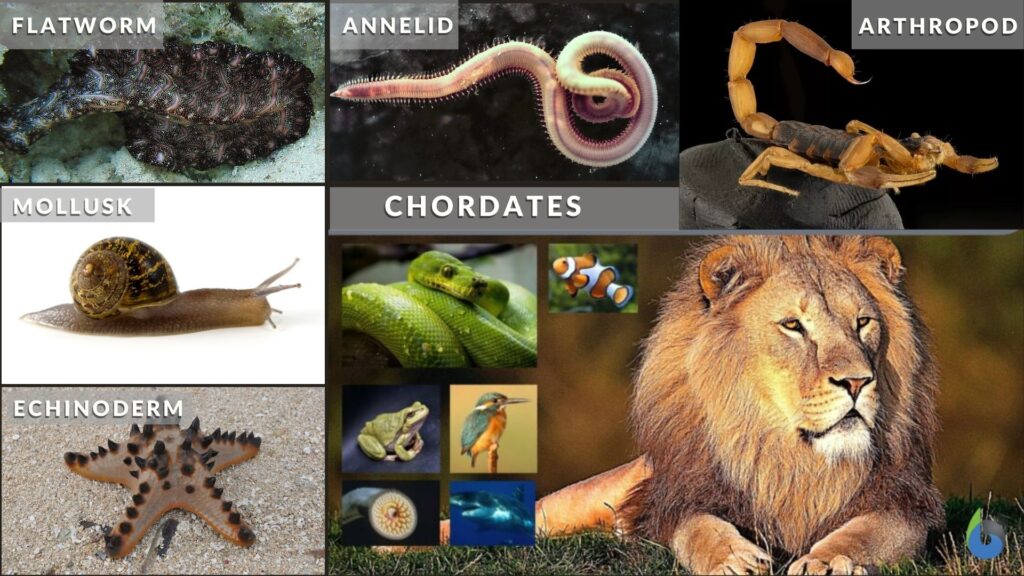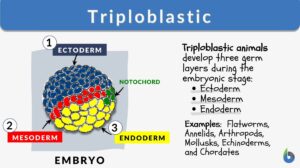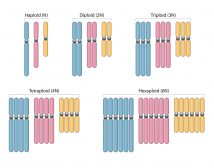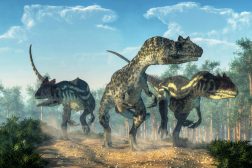
Triploblastic
adj., [ˌtrɪpləʊˈblæstɪk]
Definition: Having three primary germ layers
Table of Contents
Triploblastic Definition
A triploblastic animal had three main layers of tissue during embryonic development. The central layer is the mesoderm, which is surrounded by the upper layer –ectoderm- and the lower layer – endoderm. The formation of these three layers occurs during gastrulation. From blastula, the embryo undergoing the process of triploblasty and subsequently forms three characteristic germ layers is now referred to as “gastrula“.
Triploblastic animals, therefore, are those animals wherein during their embryonic development a third germinal layer, called mesoderm, forms between the endoderm and ectoderm.
If you would like to know the developmental stages of human embryo, read Growth and Development of a Human Baby.
Triploblastic definition biology
We can define triploblastic as having three germ layers: ectoderm, mesoderm, and endoderm. The germ layers are a group of cells that are present in an embryo. As the embryo grows, these germ cells interact with one another and lead to the formation of different body tissues and organs.
Triploblasty can be seen in multicellular animals, particularly, flatworms (Phylum Platyhelminthes), mollusks (Phylum Mollusca), arthropods (Phylum Arthropoda), and chordates (Phylum Chordata). Animals that are not triploblastic are some invertebrates like sponges (Phylum Porifera) and cnidarians (Phylum Cnidaria).

Triploblastic means having three primary germ layers, particularly ectoderm, mesoderm and endoderm. All higher and intermediate animals (i.e. from flatworms to humans develop from a triploblastic embryo, in contrast to other organisms (e.g. cnidaria) that develop from a diploblastic embryo. Etymology: Greek tripló(os), threefold + blastikós, budding. Related form: triploblasty.
Compare: monoblastic, diploblastic
Function of Triploblastic
Triploblasts are organisms whose body is derived from all three germ layers, which are the endoderm, mesoderm, and ectoderm.
- Ectoderm forms the brain, spinal cord, lens of the eye, and hairs.
- Mesoderm is responsible for the formation of notochord, bone, muscles, connective tissues, and circulatory systems.
- Endoderm leads to the formation of the stomach, liver, colon, urinary bladder, and lungs.
Due to the interface of ectoderm and endoderm, differentiation of mesodermal cells takes place. The mesoderm forms the coelom, which is the body cavity. These organisms are complex due to the presence of a body cavity.
Different organs are present in the body cavity. These organs are protected by a fluid that is present in the surrounding. In the coelom, fluid cushions protect the organs against any shock. (Sabhadiya, 2021) The organs of the body are protected against dehydration and shock due to this fluid. In higher animals, the mesoderm is a distinguishing feature as it forms lungs, liver, stomach, colon, urinary bladder, and other body organs.
From flatworms to humans, all animals are triploblastic. Humans are the supreme example of triploblastic animals.
Triploblastic animals can be further divided into two categories.
- Acoelomates (lack a coelom)
- Pseudocoelomates (have a “false” coelom)
- Eucoelomates (with true coelom)
Eucoelomates are further divided based on opening through the blastopore.
- Protostomes – mouth opening develops through the blastopore
- Deuterostomes – anal opening develops through the blastopore
Triploblastic evolutionary development: Scientists thought that about 600 years ago, triploblastic organisms (triploblastic) were developed from diploblastic organisms.
The difference between the diploblastic and triploblastic organisms is discussed here further below.
Triploblastic Examples
All animals, from flatworms to humans, are triploblastic. Below are some examples.
- Platyhelminthes: These are simple animals that are symmetrical bilaterally and have three essential germinal layers of cells. For example, Flatworms
- Annelids: These are coelomate worms, bilaterally symmetrical and triploblastic. Around their body, there is a thin flexible cuticle. For example, Polychaete, Lugworms, Earthworms, and Leeches.
- Arthropods: Arthropods also have three germinal cell layers, which means they are also triploblastic. For example, Crustaceans (barnacles, shrimp, lobsters, and crab), Arachnids (mites, spiders, and scorpions), and Insects (butterflies, beetles, bees, flies, ants, and cockroaches).
- Mollusca: These are bilaterally symmetrical and triploblastic. They have a true coelom. In Mollusca, mesodermal membranes surround the internal body cavity. For example, slugs, snails, scallops, squid, nautili, cuttlefish, octopi, and oysters.
- Echinoderms: Echinoderms are also triploblastic. They are unisexual marine animals. Their body has a tough spiny exoskeleton. For example, sea urchins and sea stars.
- Chordates: Chordate animals are triploblastic and have a backbone. Their range includes from playful dogs to ferocious cats and from small fish to giant whales.

Interesting Fact
Answer: The phylum Arthropoda animals are triploblastic. They have all three germinal layers, which are ectoderm, mesoderm, and endoderm. These layers form the head, thorax, and abdomen.

.
Difference between Diploblastic and Triploblastic
Find out the differences between diploblastic and triploblastic below.
Table 1: Diference between diploblastic animals and triploblastic animals | |
|---|---|
| Diploblastic Animals | Triploblastic Animals |
| During gastrulation, diploblastic animals form two main layers: 1. Ectoderm (external layer) 2. Endoderm (internal layer) | In triploblastic animals, three germ layers are present: 1. Ectoderm (external layer) 2. Mesoderm (middle layer) 3. Endoderm (internal layer) |
| Diploblastic animals do not have a mesodermal layer. | Triploblastic animals have a mesodermal layer that forms notochord, true organs, bones, muscles, connective tissue, and circulatory system. |
| A non-living layer named mesoglea is present between ectoderm and endoderm. Mesoglea helps in protecting the gut lining and body. | Triploblastic animals do not have mesoglea. |
| The endoderm of diploblastic animals has true tissues and intestines. | The endoderm of triploblastic animals has lungs, liver, stomach, colon, and urinary bladder. |
| The ectoderm of diploblastic animals form nephridia, nervous tissue, and epidermis. | The ectoderm of triploblastic animals forms the brain, spinal cord, blood, and lens of the eye. |
| These animals are symmetrical radially. Diploblastic are “simple” animals for not having a brain, thus, structurally less complex. | These animals are symmetrical bilaterally. They are complex animals as compared to diploblastic. |
| Coelom (body cavity) is absent. | Coelom (body cavity) is present. |
Try to answer the quiz below to check what you have learned so far about triploblastic.
References
- Anissimov, M., and Bronwyn Harris. (2017). What is a Coelom? Retrieved 28 AUGUST, 2021, from https://www.infobloom.com/what-is-a-coelom.htm
- Heyerbio6a. (2020). Triploblastic Derived from three embryonic germ layers: mesoderm, ectoderm, and endoderm. from https://heyerbio6a.fandom.com/wiki/Triploblastic
- Lakna. (2017). Difference Between Diploblastic and Triploblastic. Retrieved 28 AUGUST, 2021, from https://pediaa.com/difference-between-diploblastic-and-triploblastic/
- Martindale, M. Q., Pang, K., & Finnerty, J. R. (2004). Investigating the origins of triploblasty:mesodermal’gene expression in a diploblastic animal, the sea anemone Nematostella vectensis (phylum, Cnidaria; class, Anthozoa).
- Sabhadiya, A. (2021). The Three Germ Layers and their Function. Retrieved 28, 2021, from https://www.microblife.in/what-is-germ-layer/
- Study.com. (2021). members of the phylum Arthropoda triploblastic. Retrieved 28 AUGUST, 2021, from https://study.com/academy/answer/are-members-of-the-phylum-arthropoda-triploblastic.html
©BiologyOnline.com. Content provided and moderated by Biology Online Editors.








